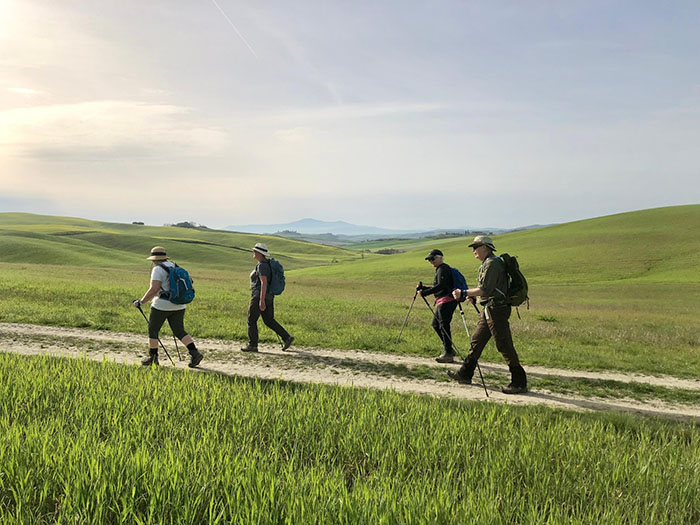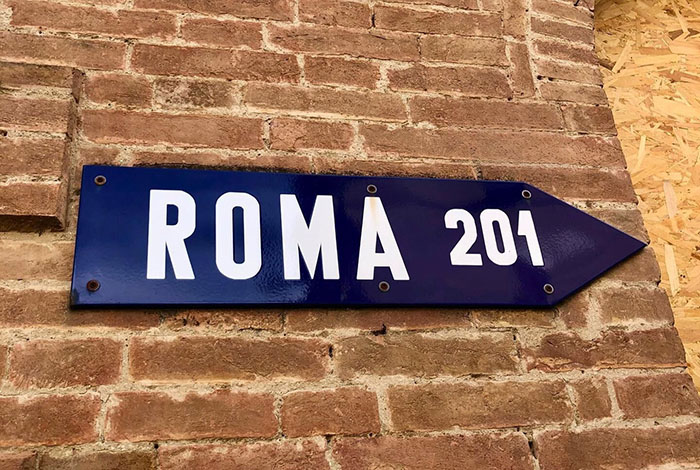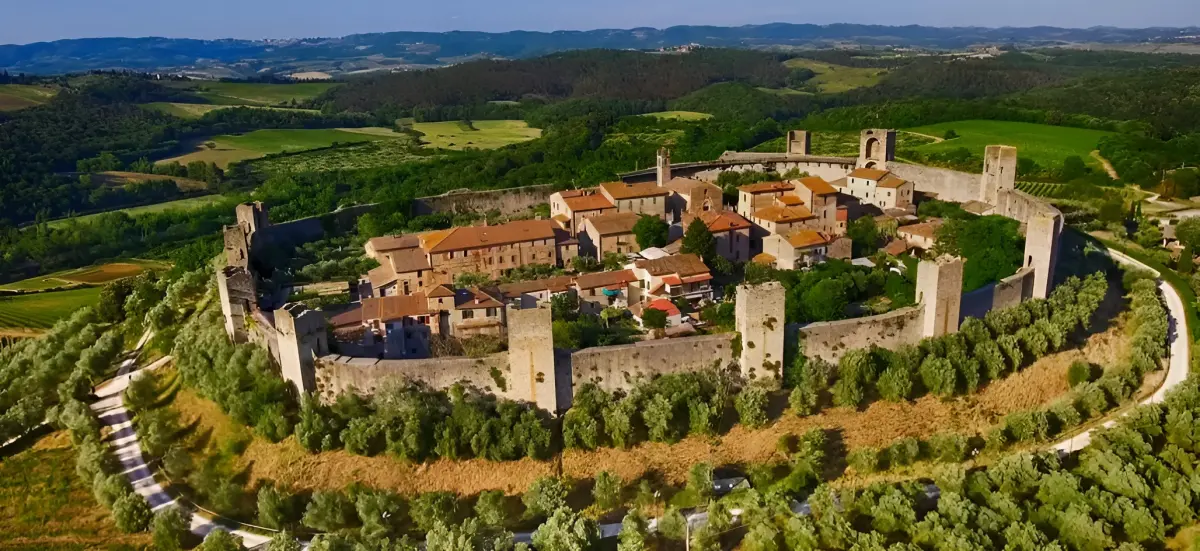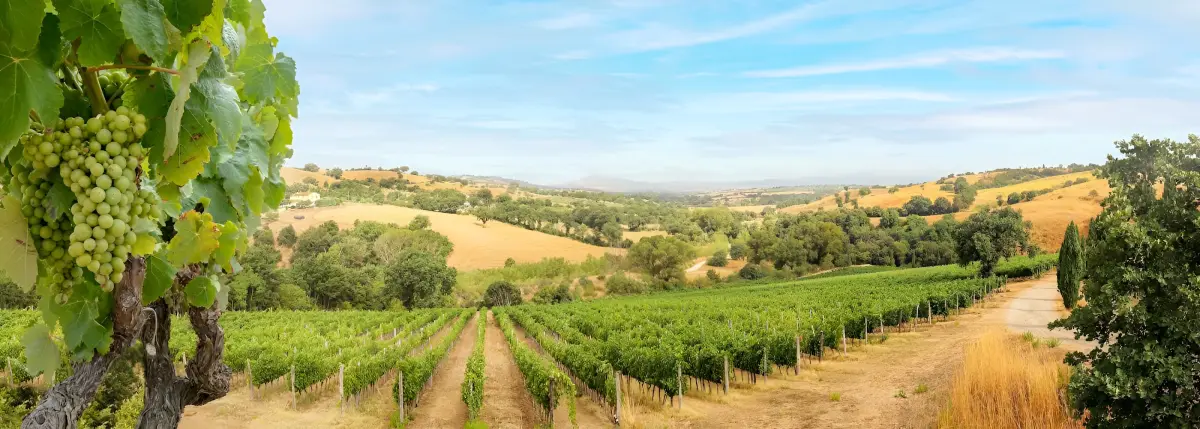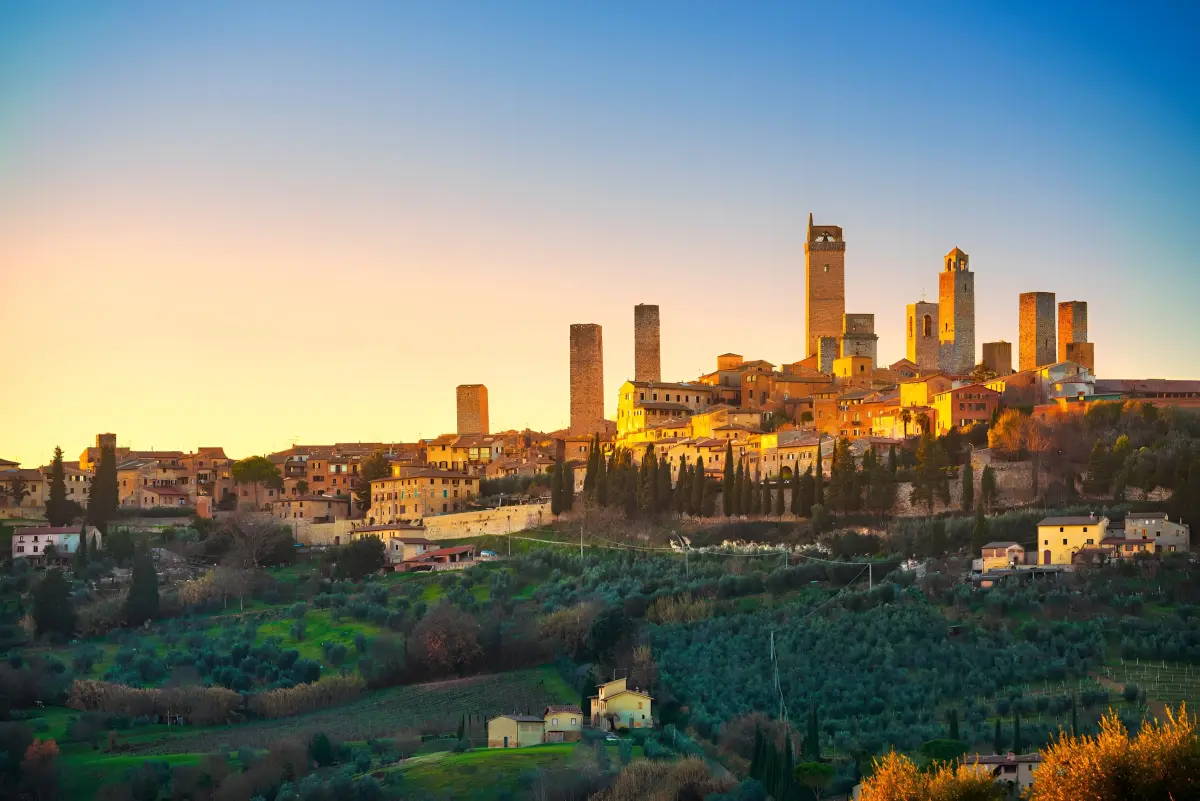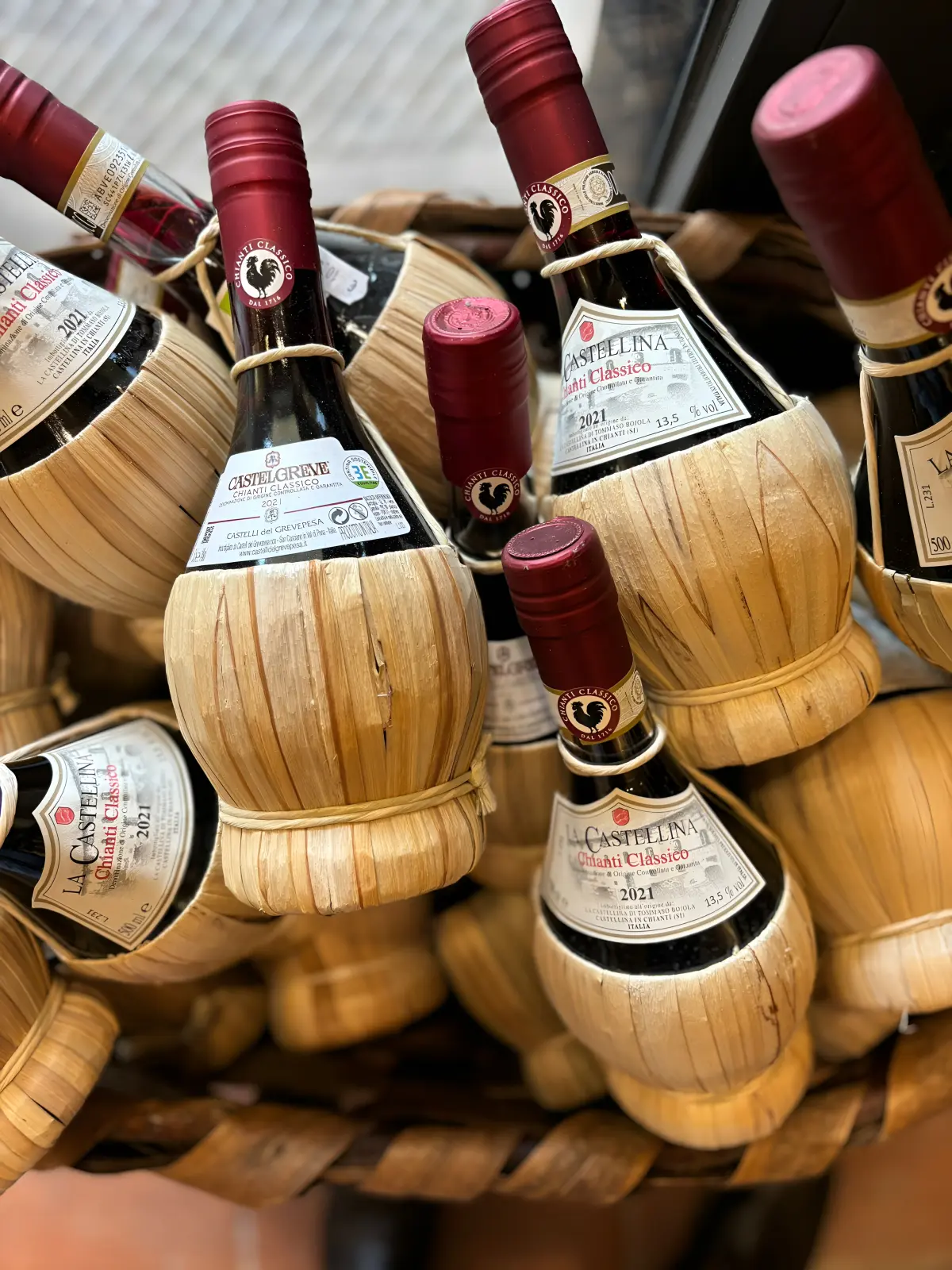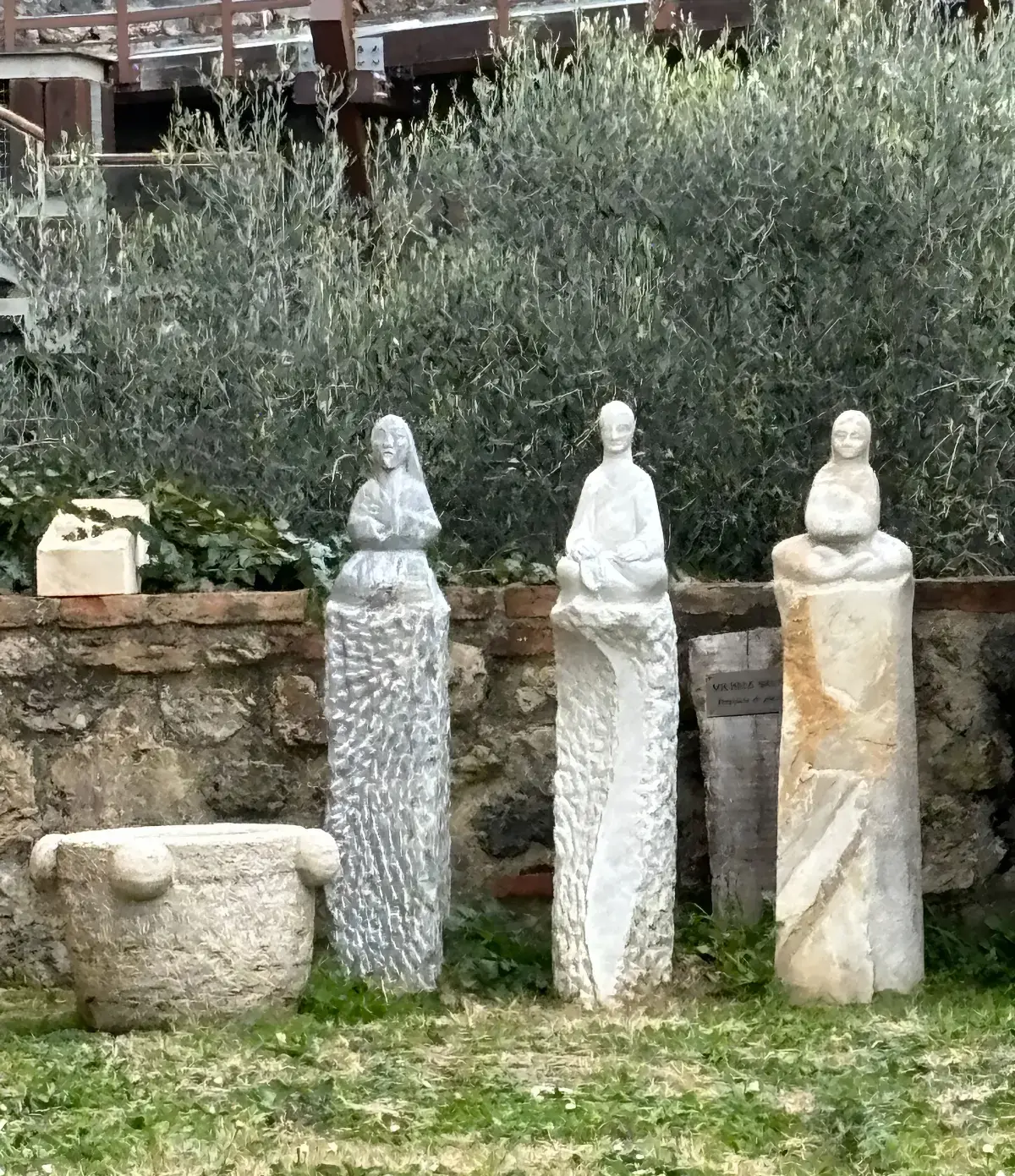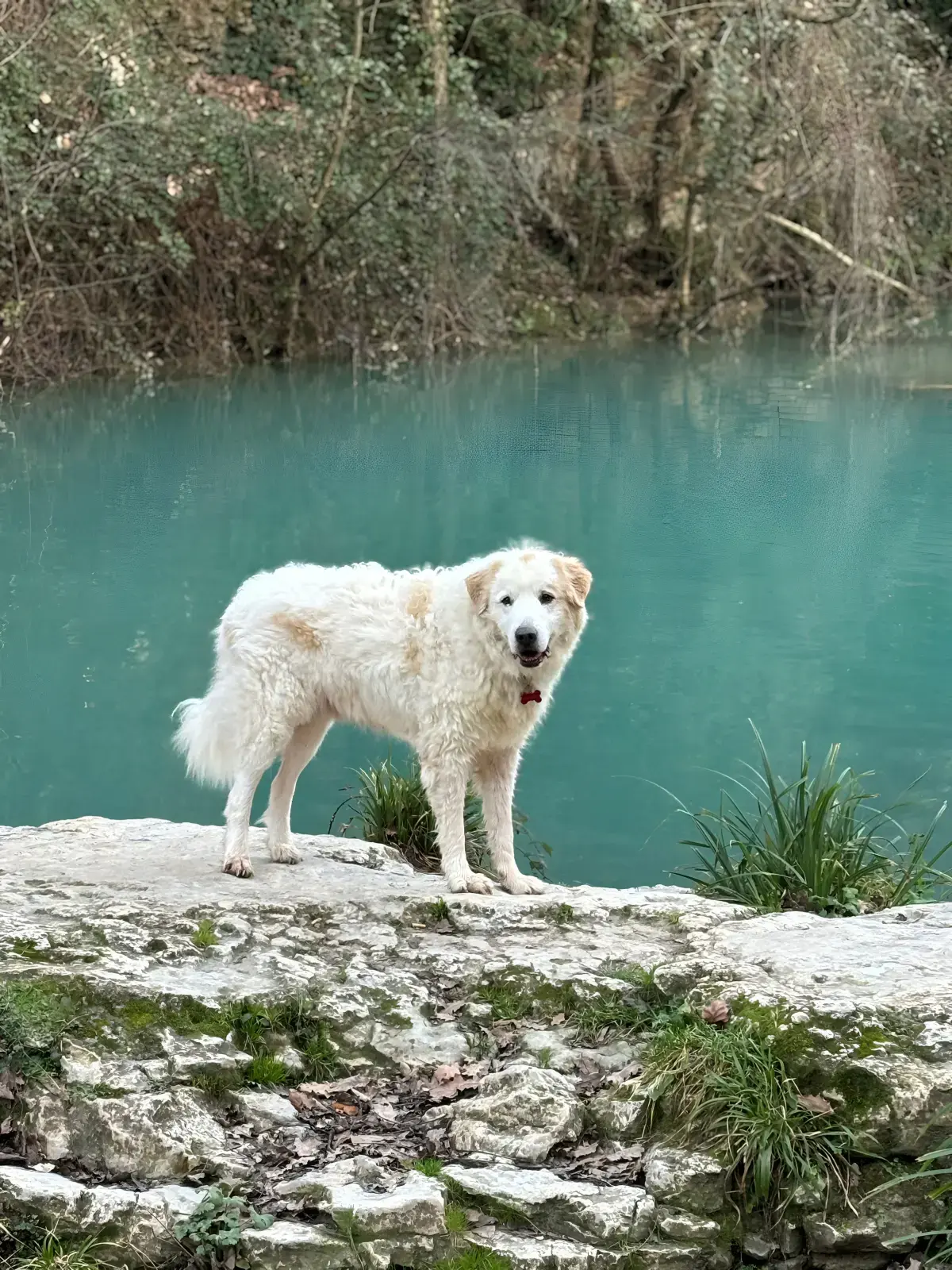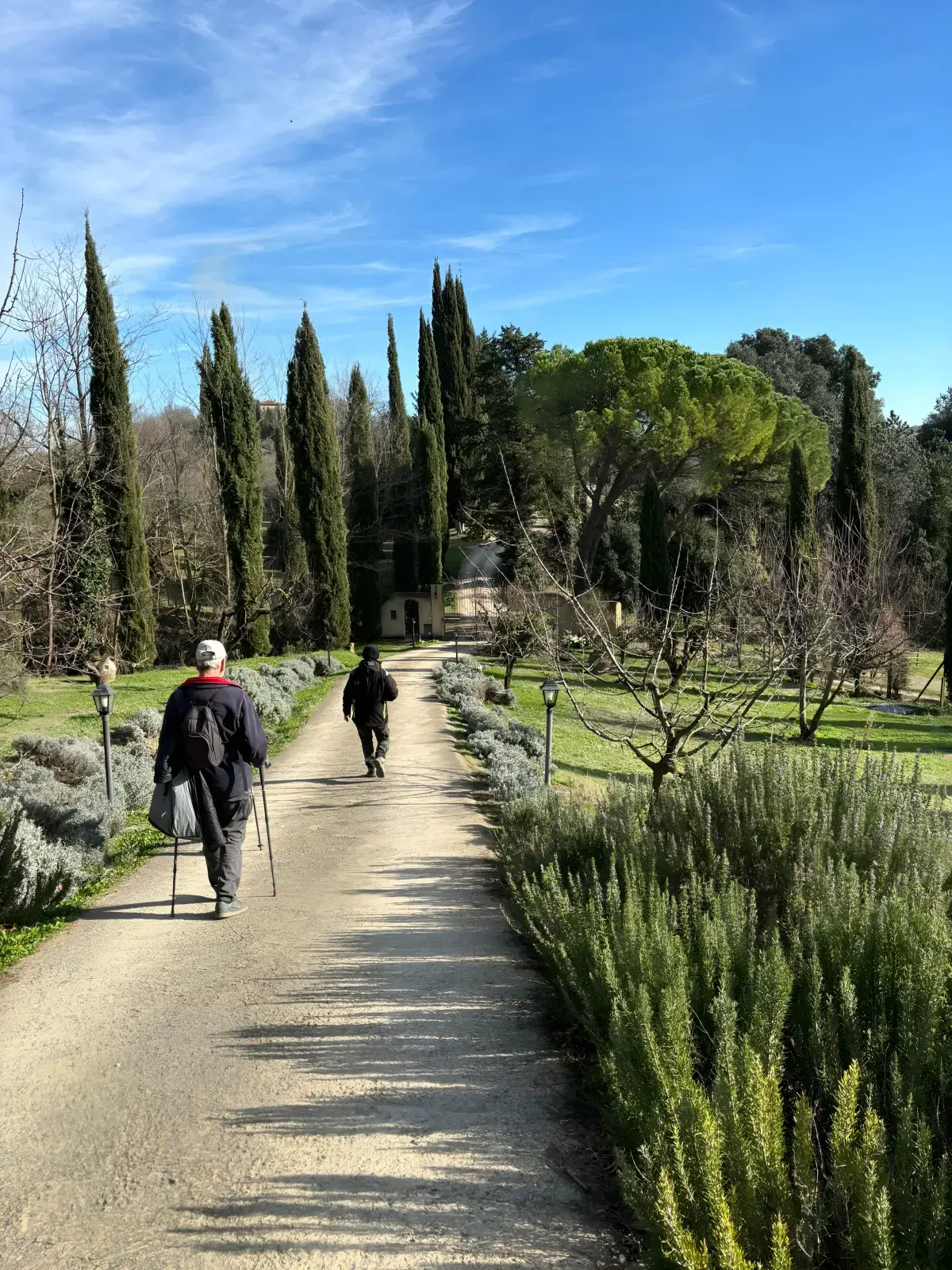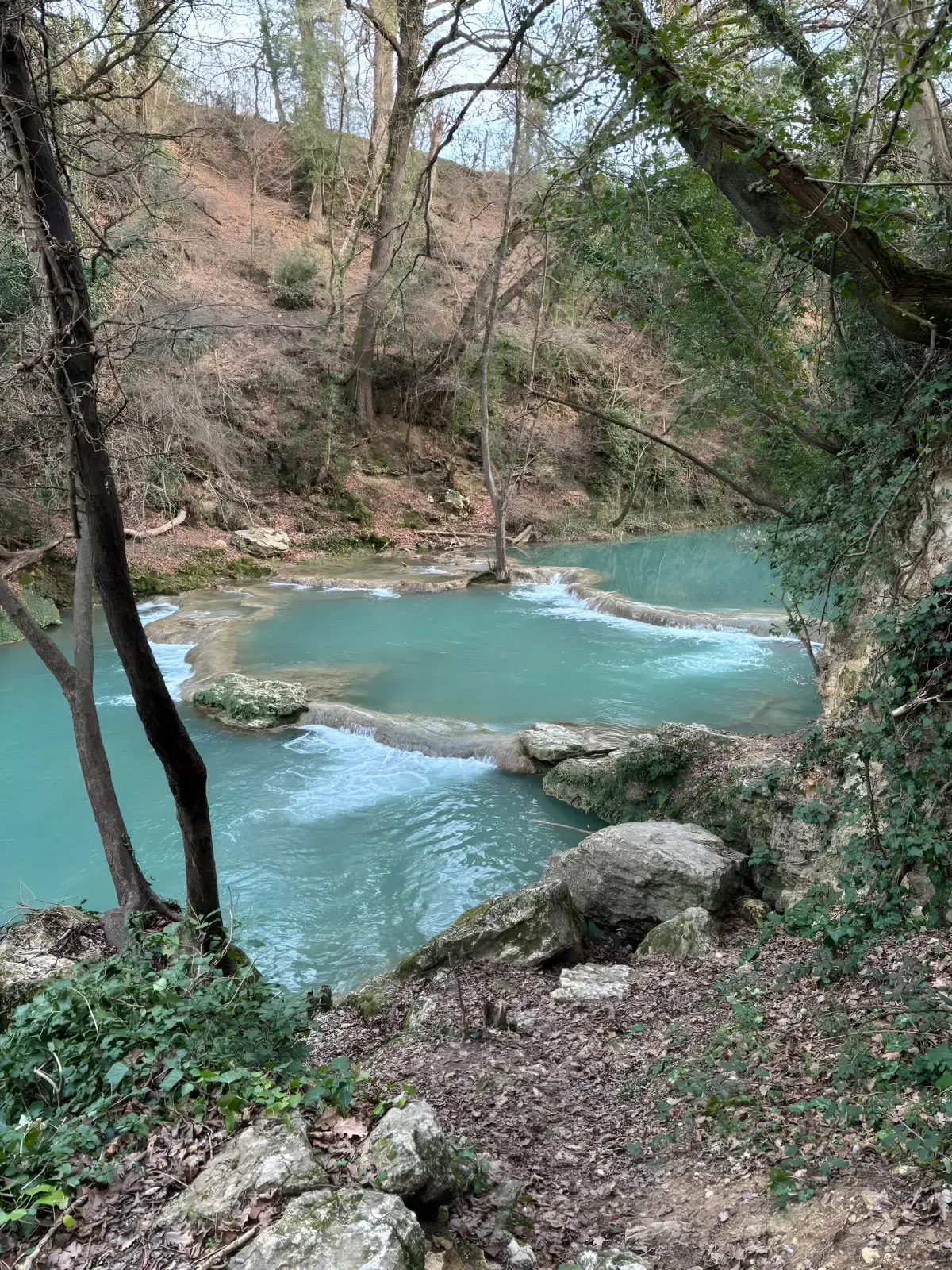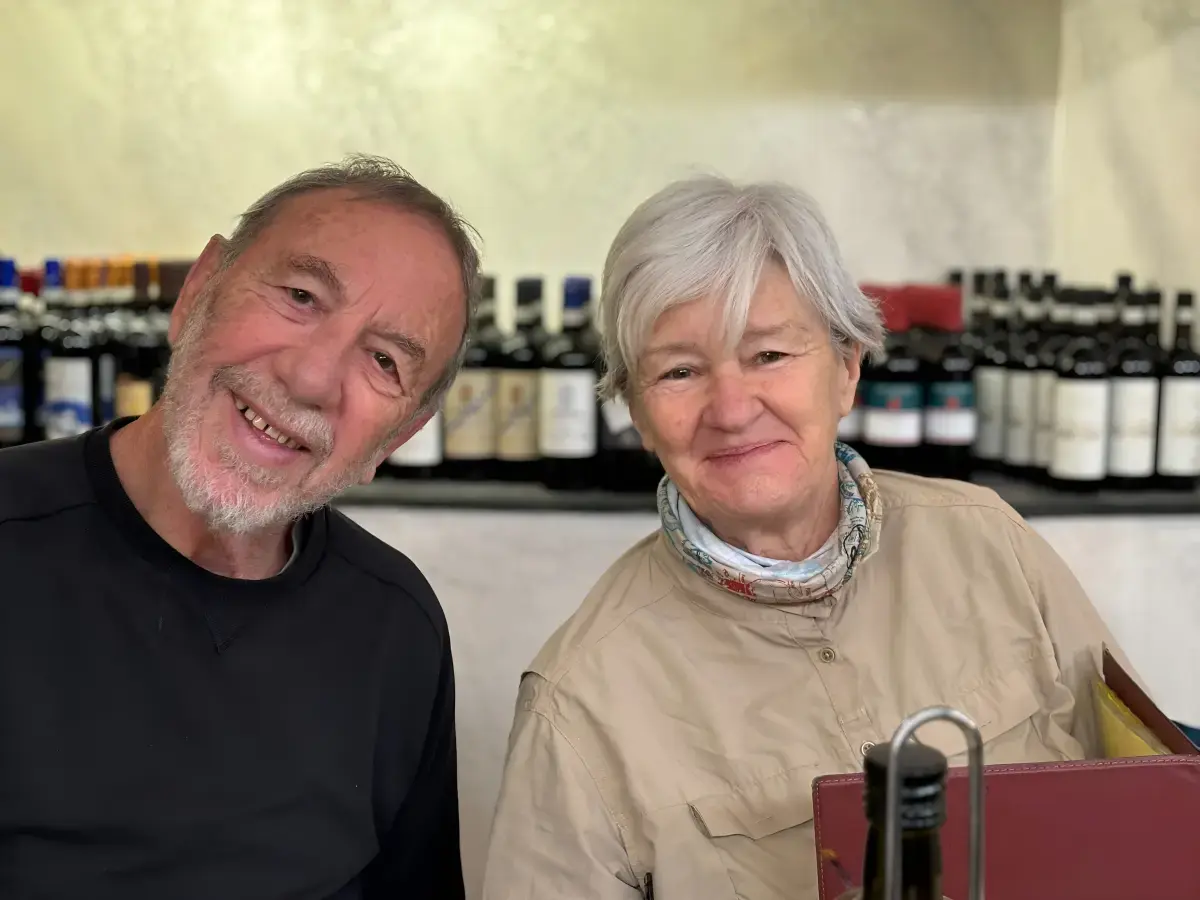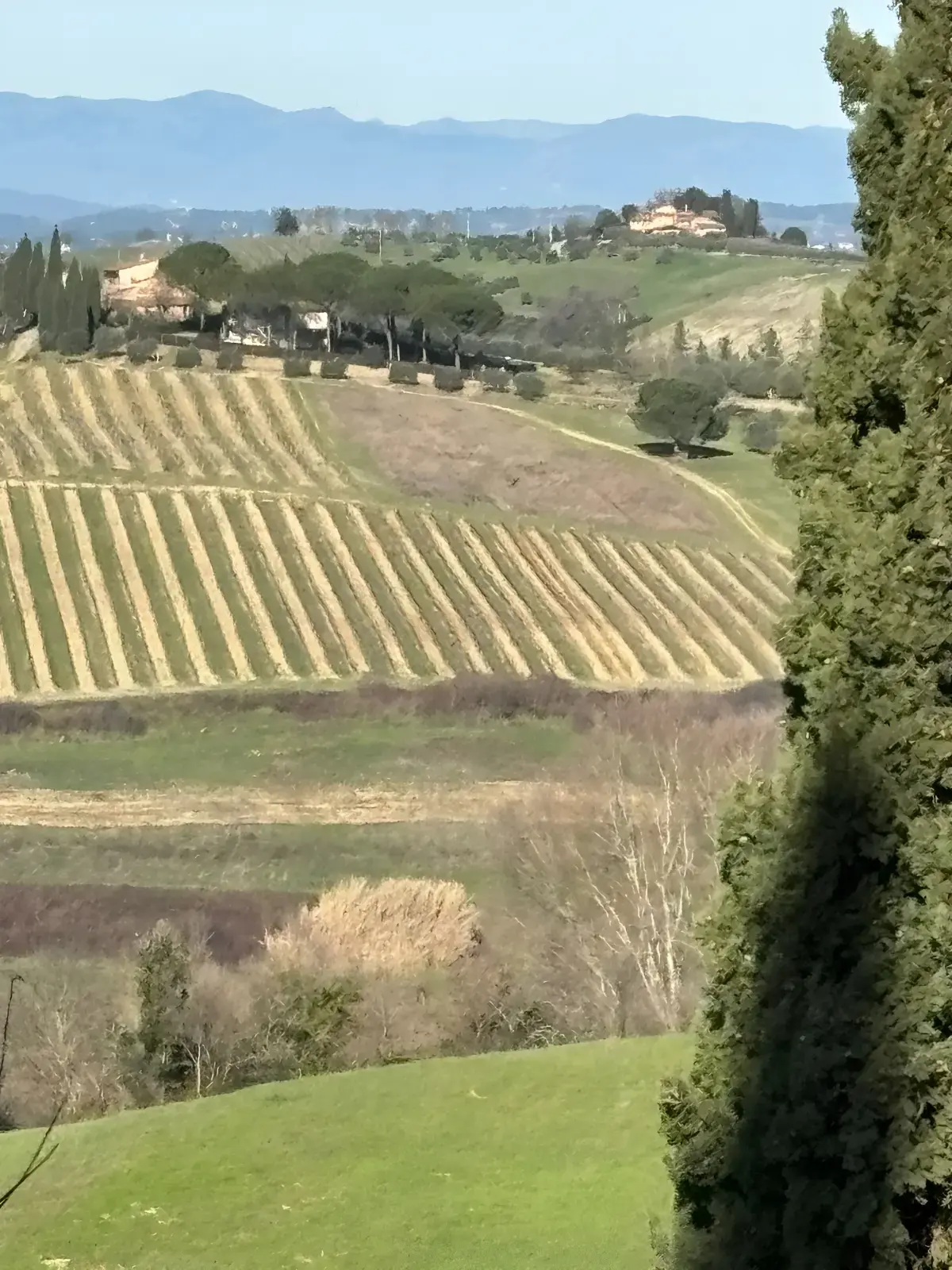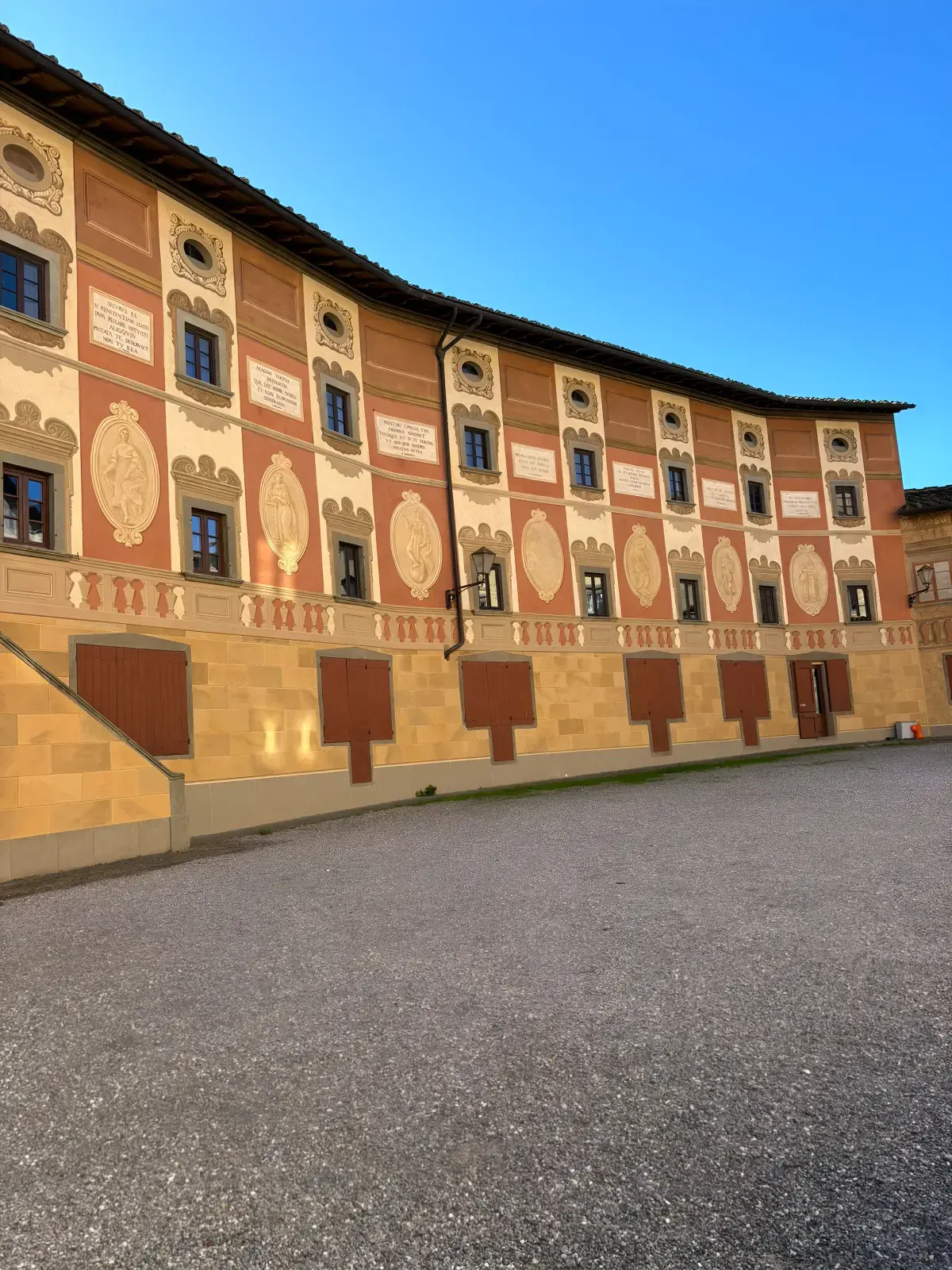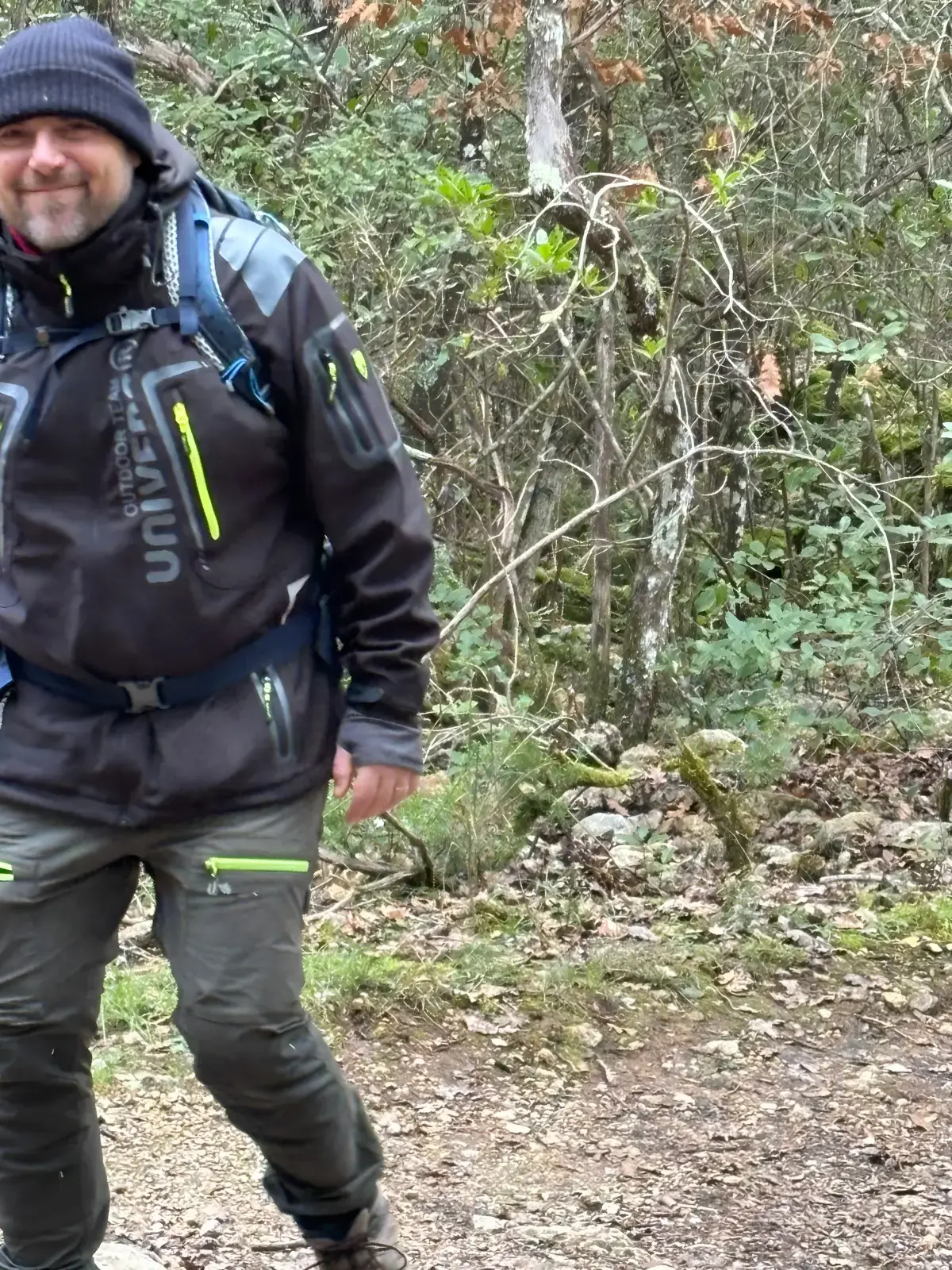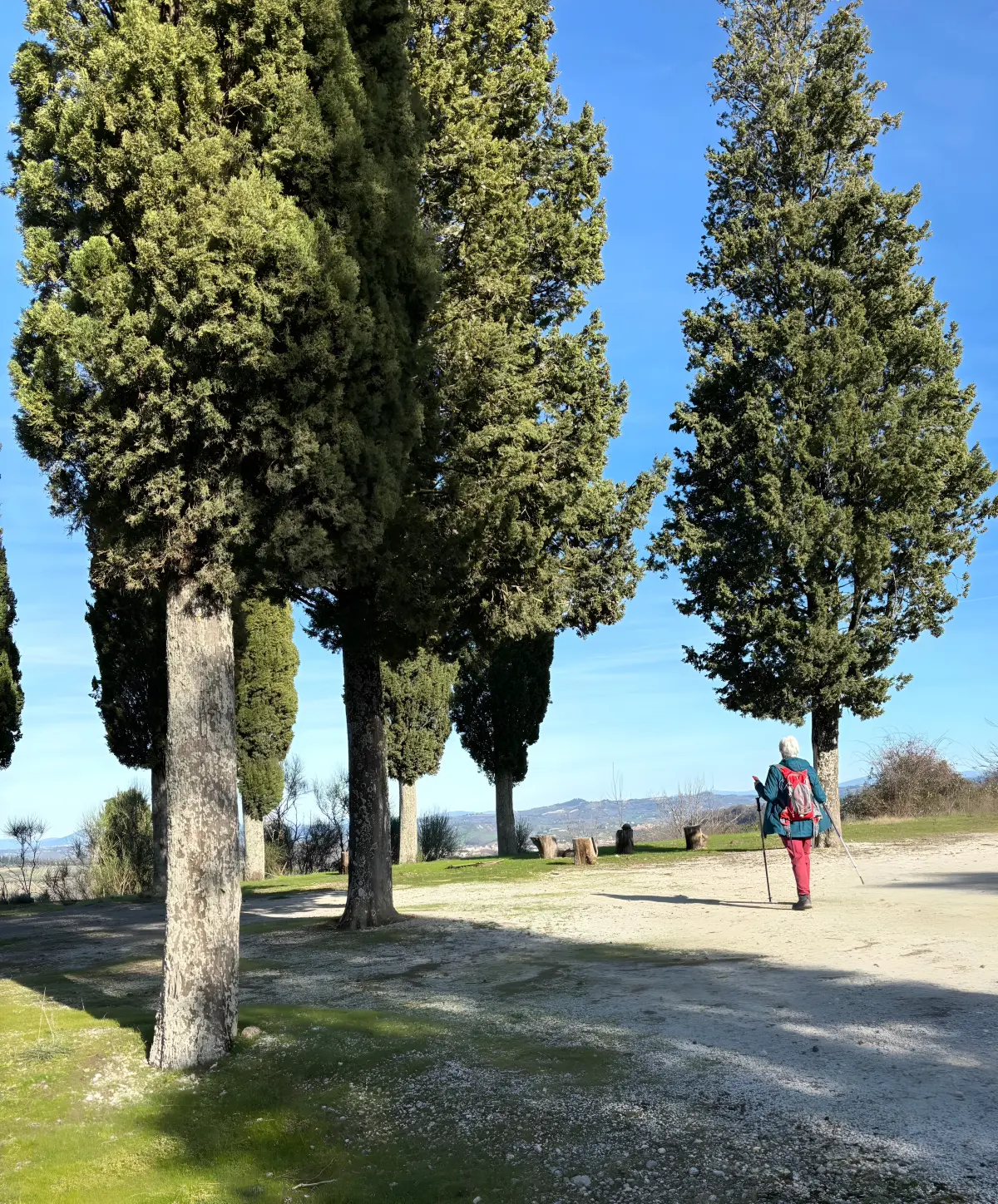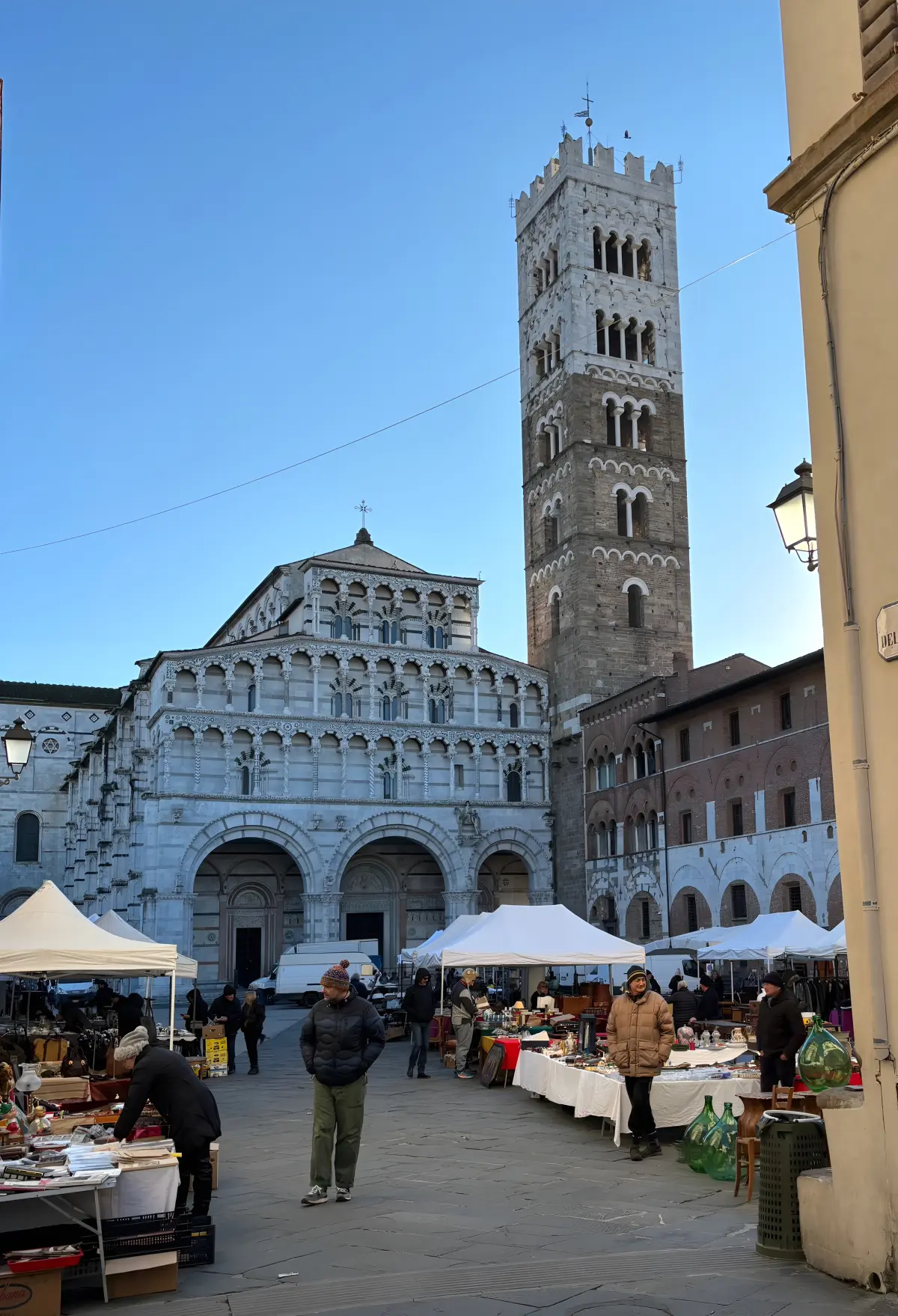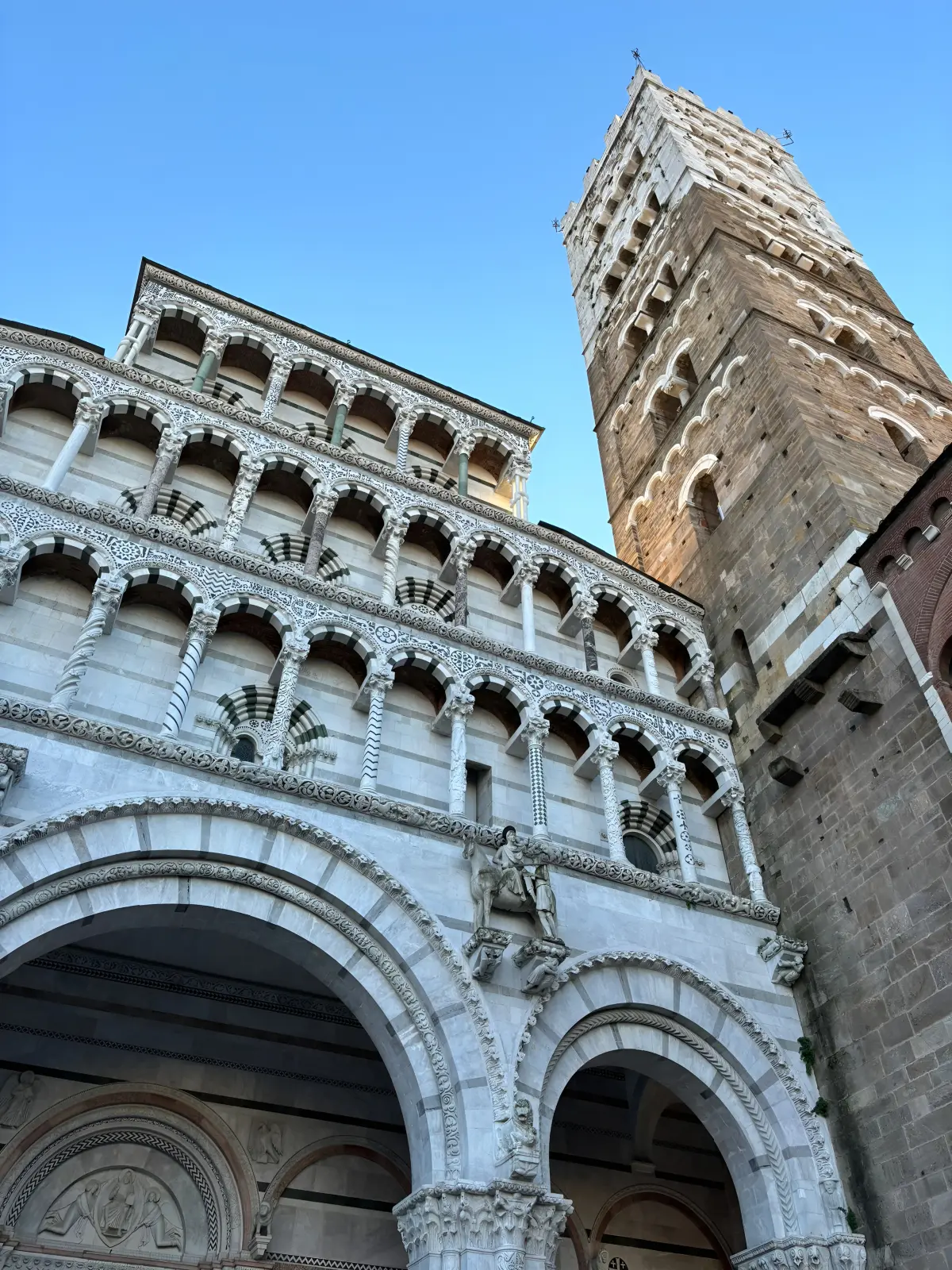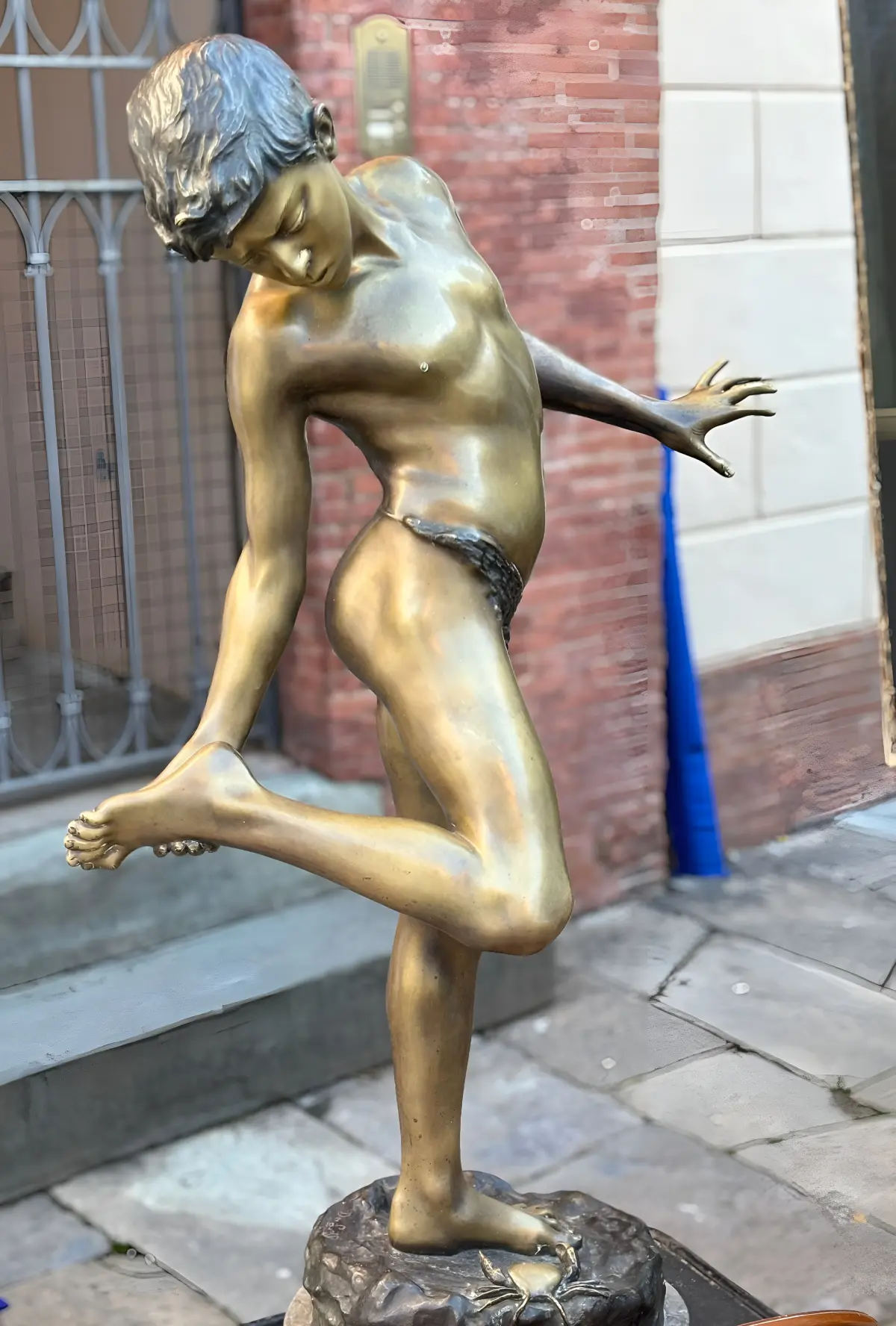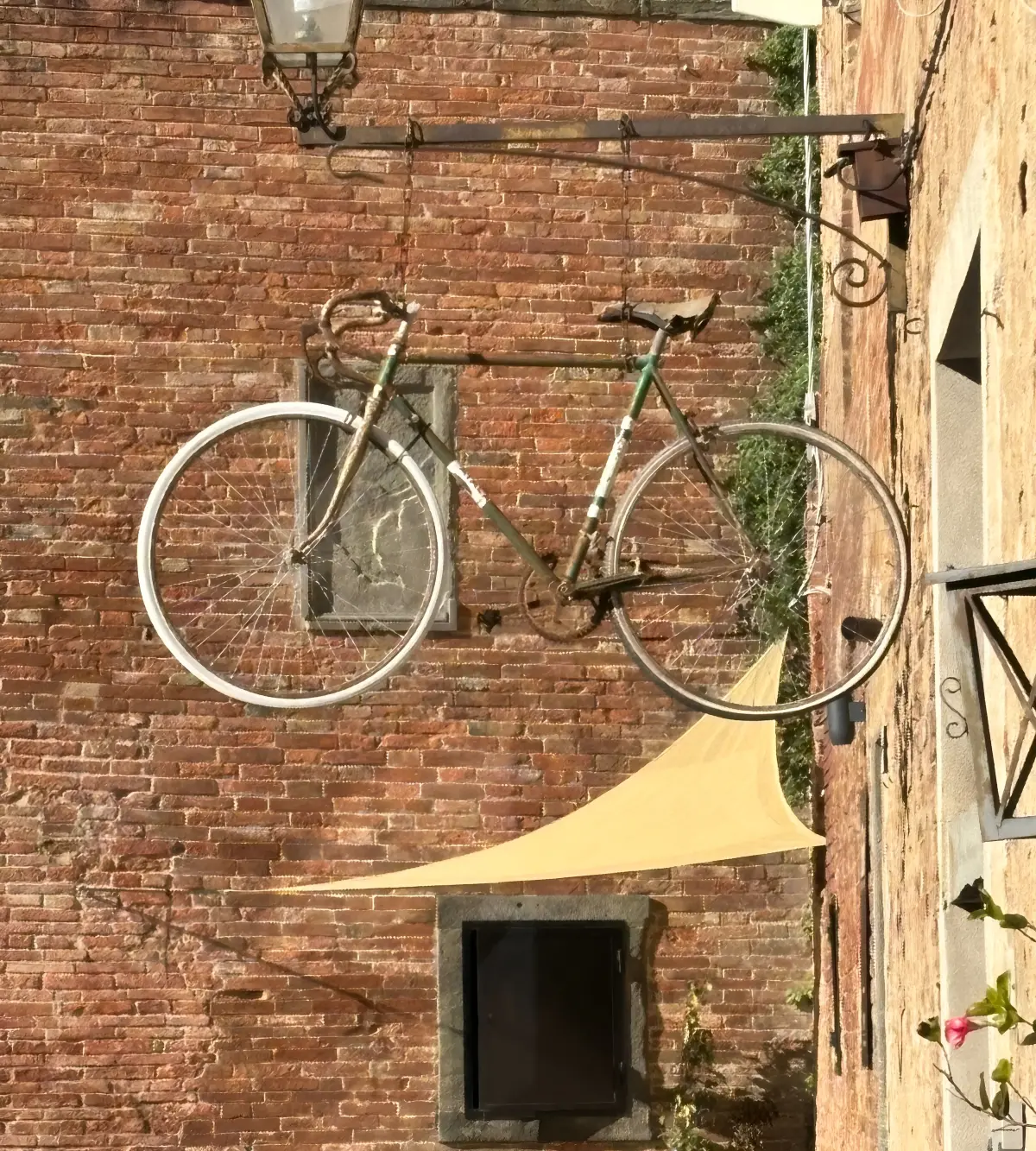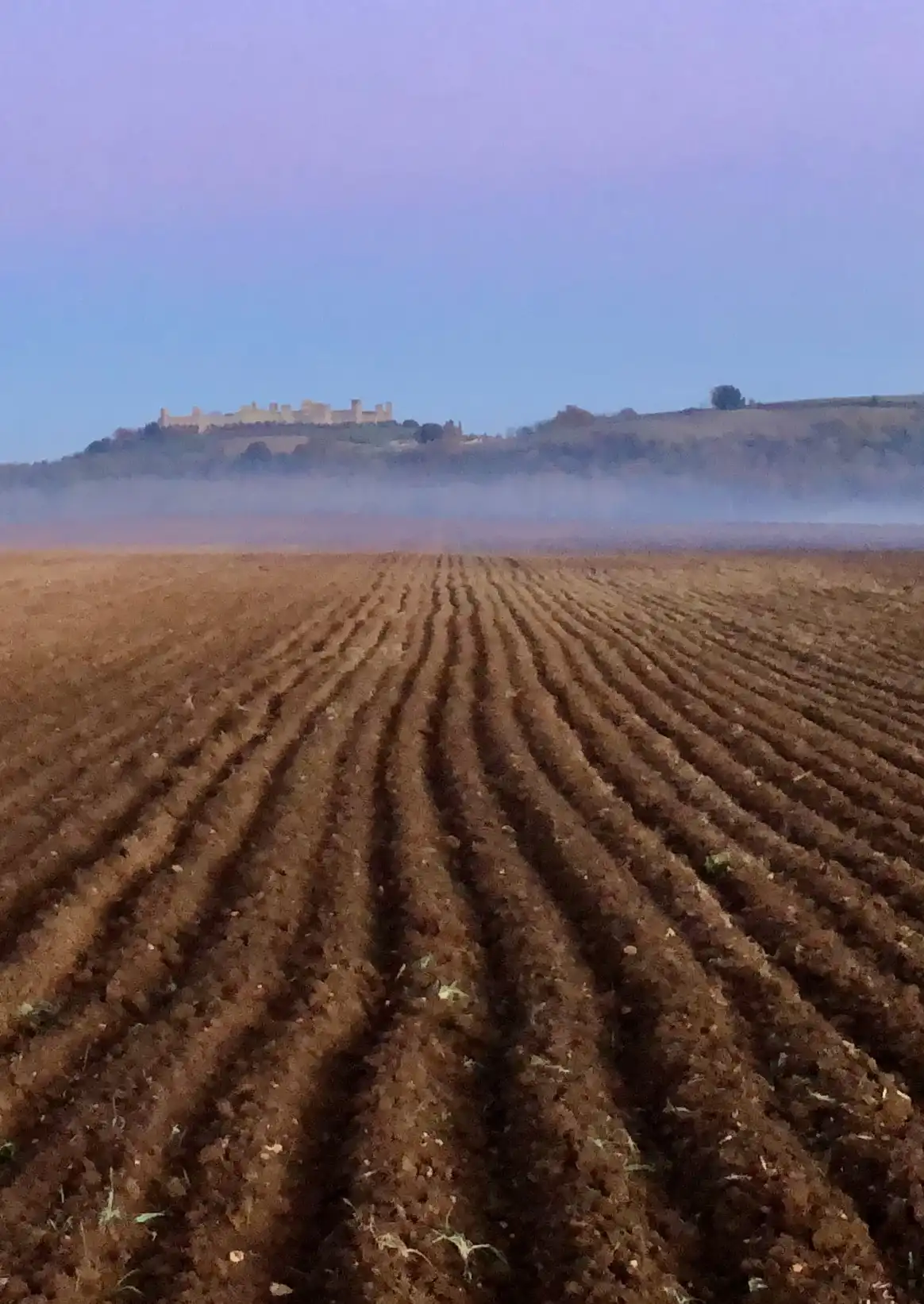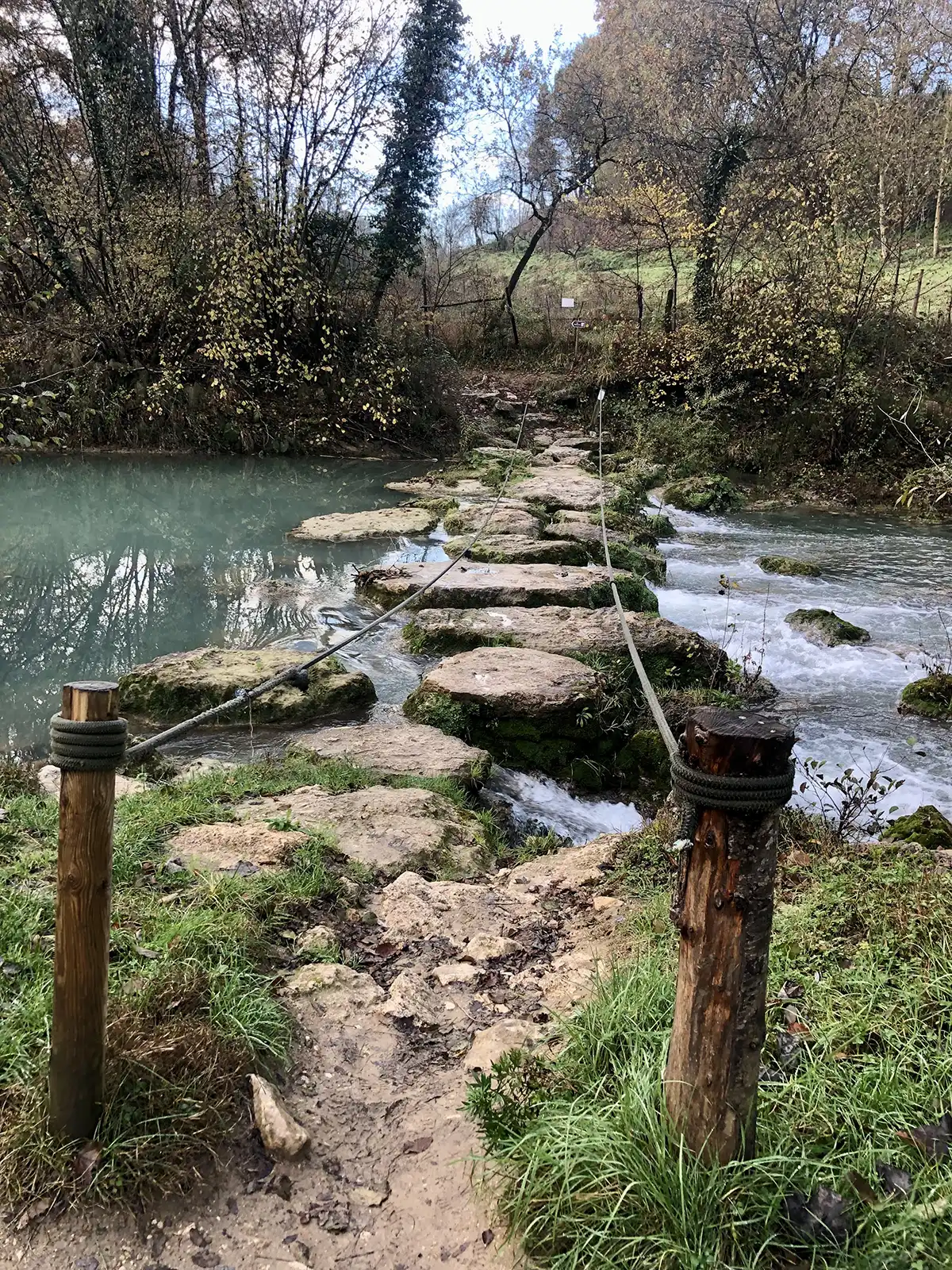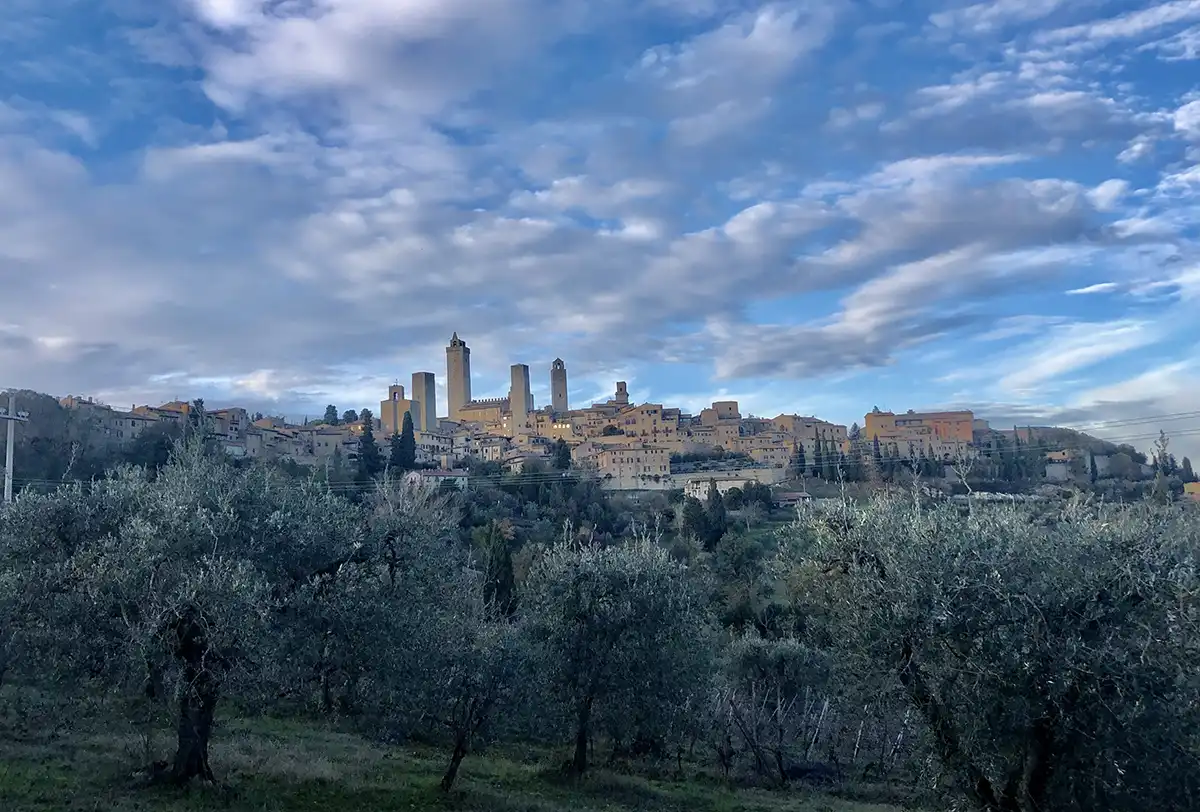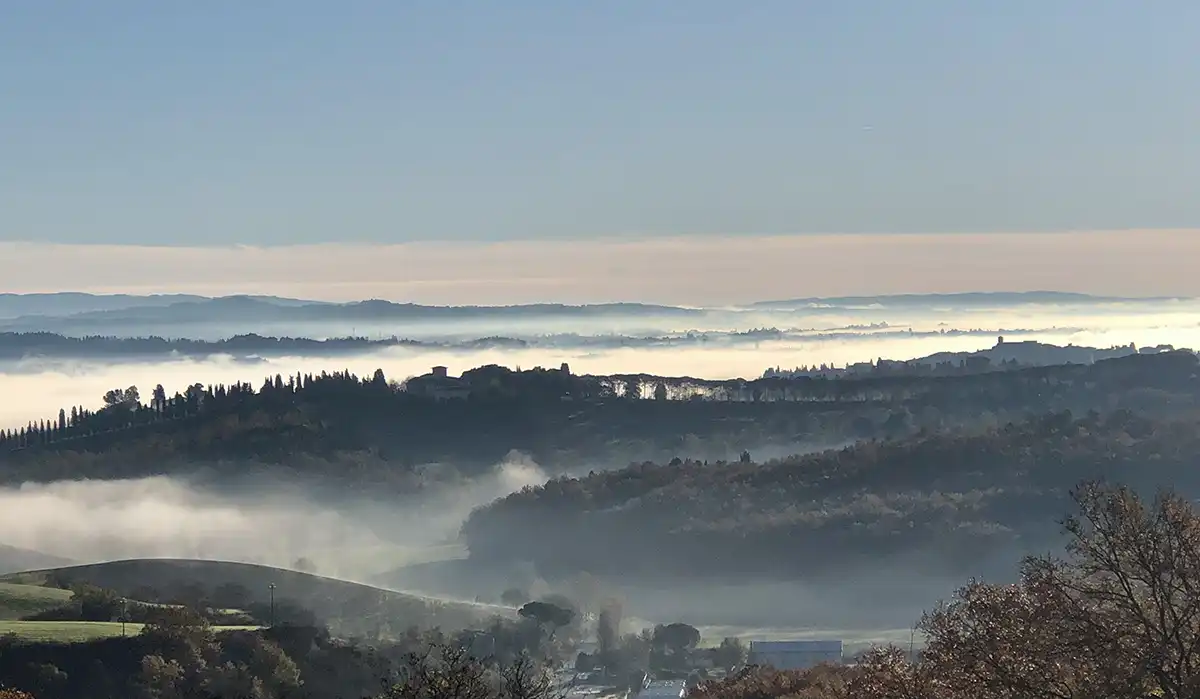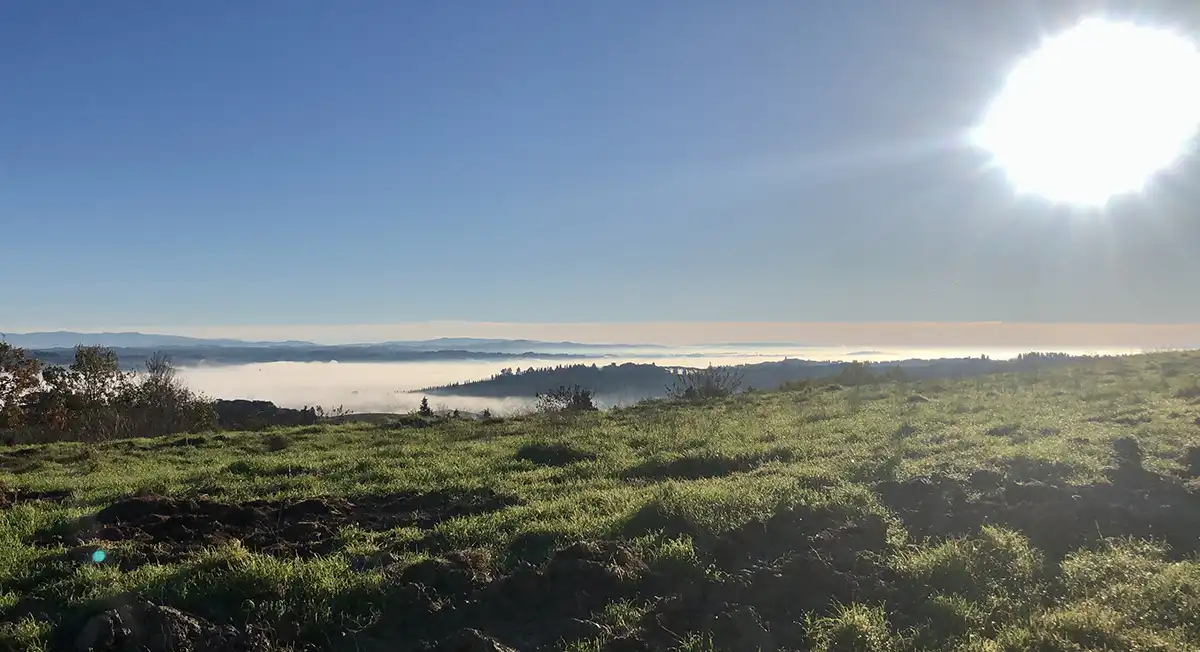
6700 EURO PER PERSON
6700 EURO PER PERSON
700 EURO SINGLE SUPPLEMENT
All roads lead to Rome, but only one of them is La Via Francigena. This legendary path follows a route traced by Julius Cesar in 58 BC called “The way of the Sun”, connecting his northern provinces with the capital, Rome. One thousand years later the Archbishop Sigericus of Canterbury traveled this route leaving a detailed description called the Iter Francorum, or the way of the Franks.
During the following centuries hundreds of thousands of pilgrims traveled to Rome by way of the Via Francigena. There were those seeking indulgences granted as early as the year 1300, merchants with goods to trade, soldiers defending their territories, emperors, bankers, diplomats, and adventurers: all walked to Rome on this road. The Via Francigena, together with the Camino de Santiago in Spain, became the backbone of the ancient road system of Western Europe throughout the middle-ages.
In 1994, this route was declared “European Cultural Itinerary” and was awarded the title of “Major Cultural Route” in 2004 by the European Council. It’s being considered by the UNESCO as one of the World Heritage Sites.
This tour will also take you to the wonderful hilltop town of Orvieto, located just few kilometres from the route and considered one of the most beautiful towns of central Italy!
All hotels, breakfasts, dinners with wine, van support w/ healthy snacks are included in the tour price.
PRIVATE tailor-made trips are available upon request. Please ask us for details.
Itinerary
Day 1: Lucca
Benvenuto!
Meet and greet your Spanish Steps guides at the hotel in Lucca, la”Città d’arte” (City of Art) at 2 PM.
From its intact Renaissance-era city walls to the elegant central plaza lined with cafes, restaurants and ‘palazzos’ we’ll wander the tiny streets and alleyways, visiting churches, galleries, and piazzas.
Still an important musical center, you’ll find the homes of Luigi Boccherini, an 18th century composer and cellist, and Giacomo Puccini, the 19thcentury composer who gave us such greats as La Bohéme, Madame Butterfly, and La Tosca.
A high-quality olive oil from Lucca has been exported throughout the world for centuries along with wines from the Colline Lucchesi, the rolling hills that we’re about to set out on.
The day isn’t over yet. We’ll meet in the dining room of the hotel to chat about the upcoming week and to celebrate with a typical Tuscan dinner.
A welcoming dinner is included.
Day 2: San Miniato
We’ll start our day by getting a pilgrim stamp in our passports. From the cathedral, we’ll make our way to the Via Roma and head south to the gate of Porta Elsa where the pilgrimage trail leaves the city. Once at this gate, you’ll want to thank your guides for getting a lift out of the city as the first stage of the Via Francigena from Lucca is mainly along a busy highway and through industrial parks. From the small town of Galleno we’ll walk the most beautiful sections of the trail through forests and along canals to reach Fucecchio. A short drive will take us across the Arno River and up to the hill town of San Miniato where we’ll spend the night.
San Miniato is most famous for its world-renowned truffle market each year. The surrounding area produces some of the finest white truffles in the world so much of the local cuisine is infused with these aromatic fungi.
The historic center that has been largely untouched by time and is perfect for an evening stroll and taking in the panoramic views of the Tuscan countryside.
A visit to the brick Duomo and the small art museum before dinner is worthwhile to glimpse the likes of Filippo Lippi, Fra Bartolomeo, and Verrocchio. 12 km / 7.5 miles. Breakfast and dinner included.
Day 3: Gambassi Terme
This will be one of the most challenging days as we hit the hills of Tuscany on this forested section of the trail. Departing San Miniato we will encounter the Tuscan hills, surrounded by the enchanted scenery and the shade of the chestnut and oak trees that will eventually open out into sweeping views of the countryside. We will stop for a light lunch at a local winery.
An ancient land, once home to Etruscans and Romans, Gambassi was the stopping place for wayfarers and pilgrims traveling the Via Francigena in the Middle Ages. The “Terme della Via Francigena” spa stands in this happy setting, nestled in magical centuries-old woodland offering a wide range of wellness programs.
17 km / 10.6 miles.
Breakfast included. Dinner on your own tonight.
Day 4: San Gimignano
One of the shortest days on our journey but laden with optical pleasures as we take in the views of this splendid medieval town with its many tall, elegant towers. Our walk will take us across the wonderful countryside to finally reach the Pieve di Cellole, an amazingly preserved XII Century church which also inspired one of Puccini’s operas. We’ll shuttle from here to San Gimignano.
A hilltop setting, San Gimignano is known for its medieval architecture and the preservation of a dozen towers as well as Romanesque and Gothic churches and handsome palazzos making this one of UNESCO World Heritage Sites. There once stood 72 towers used in textile production, but many were destroyed during family feuds and religious wars. There’s a reason why it’s called the medieval Manhattan! Originally built over an ancient Etruscan site it later became a stopping point on the Via Francigena.
Leading up to the town, you’ll find yourself in vineyards of the Vernaccia grape variety, a crisp white wine with a citrus essence. Saffron is one of the products cultivated in the fields alongside the grapes. It’s mainly used in cooking but was once the main dye for the fabrics that were produced here.
The streets will roll up once the tourist buses depart for the night leaving you to wallow in history and any ghosts that you happen to cross paths with. 12 km / 7.5 miles.
Breakfast included. Dinner will be on your own.
Day 5: Colle di Val d’Elsa
Say goodbye to San Gimignano as a pleasant walk will lead us away from the city gate to another hilltop town, Colle di Val d’Elsa. Take in the sweeping views of the undulating countryside thick with olive groves, vineyards, and hill towns. We enter Colle through the Porta Nova to the Colle Alta where we will spend the night. In the afternoon you can wonder around town and take the oppotunity to visit shops and showrooms of the several crystal manufacturers that keeps the art of glass making alive, a tradition that dates back some 800 years in this area. 11 km / 6.8 miles.
Breakfast and dinner included.
Day 6: Monteriggioni
This morning we leave town by way of the Elsa River National Park. The trail follows and crosses the river several times and it is a common destination for local families’ picnics and fishing. More Tuscan charm awaits as we trek through forest, villages, and vineyards.
Once we reach the base of Monte Maggio, we come to a Romanesque stone abbey founded in 1001 by a noblewoman named Ava of the Staggia family. This site, Abbadia d’Isola, was once surrounded by water and served as a pilgrim’s inn for travelers to Rome but became decimated by constant battles over the centuries. The abbey has since been restored and some of the outer buildings are used for events.
A steep path leads us up into a scene of the Divine Comedy. As we cross through the gate, we step back in time to the Dante Alighieri days of poetry and plague, into the magical medieval gem of Monteriggioni.
Kick back at a café on the Piazza Roma and take in the 14 towers and the fortified walls built in the 13th century. 17 km / 10.6 miles. Breakfast and dinner included.
Day 7: Siena
Arrivederci Monteriggioni! Our final day of walking will take us through the quietest section of the Via Francigena – limited cafes and services on this stretch of the trail.
The walk will be through pleasant countryside with hill towns and towers off in the distance. At kilometer 10, we will board the van one last time to skip the busy roads into Siena and get dropped off at Viale Cavour where we walk through the gate of Camolia, which will eventually lead us to the Piazza del Campo where a celebratory bottle of Prosecco awaits. At the Cathedral Pilgrim office, we’ll be awarded the certificate of completion. Complimenti Pellegrini! You made it.
10 km / 6.2 miles. Breakfast and our farewell dinner included.
Day 8: SIENA – COLLE MALAMERENDA
A local historian will guide us around the city to learn about the history of the Guelphs and the Ghibellines, the 17 contrade that make up the fabric of the city, the Doumo, and the exciting Palio horse race that takes place in July and August. From the gate of Porta Romana, we leave Siena to continue this epic journey into the hills of Tuscany. We spend the night in a charming Agriturismo. 12 km/7.5 miles – Dinner included.
Day 9: COLLE MALAMERENDA – PONTE D’ARBIA
Across open meadows and along the Strade Bianche (white roads) today’s walk will allow us spectacular views of the hilltop town of Lucignano, declared a National Monument. Once we reach Ponte d’Arbia, our destination, we will have a short shuttle back to our hotel, where we spend a second night.
19 km/11.8 miles – Breakfast and Dinner included.
Day 10: PONTE D’ARBIA – TORRENIERI
An easy walk leads us to Buonconvento at the confluence of the Arbia and Ombrone rivers. This is an important agricultural center which flourished in ancient times due to its location on the pilgrimage road. We’ll follow a trail that goes along the crest of the Southern hills of Siena and through the famous vineyards of Montalcino, where we enjoy the taste of some of Italy’s best wines. We then reach the small town of Torrenieri and take a short shuttle to our hotel in San Quirico d’Orcia.
18 km/11.2m – Breakfast and lunch with wine tasting included.
Day 11: SAN QUIRICO – CASTIGLIONE D’ORCIA
Well-marked footpaths will take us into magical land of the Val d’Orcia and the perfectly preserved village of San Quirico d’Orcia where the ancient Etruscans once resided. Bagno Vignoni is the next village on the route, a favourite resting place where Romans would luxuriate in the hot waters of the thermal baths. Next, we continue our way to Castiglione, located on a hill at the foot of Mount Amiata. Overlooking Castiglione is the watch tower of Rocca di Tentennano. A beautiful walk down into the valley leads us to the Ospitale delle Briccole, where there once stood an ancient pilgrim’s hospital. We end our day’s journey in a lovely Agriturismo. 23 km/14.3 miles – Breakfast and Dinner included.
Day 12: CASTIGLIONE D’ORCIA – PROCENO
The path now begins to climb, but our goal of the hilltop village of Radicofani is always in sight. Set on top of a 780-meter hill stands the mighty Rocca of Radicofani, a Carolingian castle built over 1000 years ago. This has always been one of the biggest challenges for pilgrims on the Road to Rome. Worth visiting are the Romanesque church of San Pietro and the one of S. Agata, in the town center, which house some works by sculptor Andrea della Robbia. After a short shuttle we continue onwards crossing the border between Tuscany and Latium and reach Proceno, our destination of the day.
19 km/11.8 miles – Breakfast and Dinner included.
DAY 13: ACQUAPENDENTE – BOLSENA
We continue our route to reach the lovely town of Acquapendente, where we visit the Romanesque cathedral of the Santo Sepolcro, who’s unusual 10th century crypt contains a blood-stained stone from the Holy Sepulchre of Jerusalem.
Today we enjoy great views of the former volcanic crater, now Lake Bolsena, the largest natural volcanic lake in Europe. A pleasant walk-through olive groves, open meadows, and small forests, passing by tiny houses built into giant lava cliffs, leads us to the shores of the lake and the attractive town of Bolsena, with its medieval quarter and black-sand beach.
19 km/11.8 miles – Breakfast included.
DAY 14: BOLSENA – ORVIETO
Following the steps of the ancient population of Bolsena who in 1263 walked to Orvieto to hand the relic of the Eucharistic miracle to the Pope we walk a beautiful trail that connected the two towns since the Etruscan times. The easy and short walk gives us time to enjoy one of the most beautiful towns in central Italy, rich in art, history, cuisine, and wines.
7 km/4.3 miles, breakfast and dinner.
DAY 15: ORVIETO – BOLSENA – MONTEFIASCONE
We start the day visiting the amazing cathedral of Orvieto, and then move back to our trail. Today is a delightful walk-through luscious forest with dappled shade into Turona Park Nature Reserve, boasting tranquil pathways alongside the rushing River Turona. These footpaths will eventually lead us to the Via Cassia, an ancient trade route and Roman Road still in use today after 20 centuries. We end our day arriving at Montefiascone, a small town built high on volcanic rock offering not only impressive views, but also good wine and delicious cuisine.
18 km/11.2 miles – Breakfast and dinner included.
DAY 16: MONTEFIASCONE – VITERBO
Wide-open plains dotted by small hills separate Montefiascone from Viterbo. Today’s route starts with one of the best preserved stretches of the ancient Via Cassia as it takes us through vast wheat fields. This trek will lead us to the capital of Tuscia, the town of Viterbo, rich in Etruscan origins and medieval monuments. Also known as the city of the popes, Viterbo was the papal seat in the XIII century. Virginio, your guide, is proud to show off his hometown, Viterbo, and the peperino (grey volcanic rock) alleyways of the exquisite medieval quarter San Pellegrino, guaranteed to bring us back in time to the middle-ages. 16 km/10 miles – Breakfast, lunch with cheese tasting and dinner included.
DAY 17: VITERBO – RONCIGLIONE
The thick woods of the Cimini Mountains have always been a natural obstacle for travellers. Even the brave Romans would not dare to cross them directly but preferred to take longer but safer routes. Fortunately, times have changed, and the crossing of this area is easier today. The beauty of the natural reserve abounds in its rewards: chestnuts, oaks, maples, and the lush “depressed” beech forest of Mount Venere surround the lake of Vico. The Etruscans, by excavating an incredible underground tunnel to drain the water and create a fertile territory for agriculture, artificially modified the shape and size of the lake. Short shuttle back to our hotel in Viterbo.
16 km/10 miles – Breakfast and dinner
DAY 18: VETRALLA – SUTRI
Walking across hazelnut groves we reach Capranica, famous for its mineral water spring. A wonderful path fully immersed in the nature leads then to Sutri, where we walk directly through the stunning archaeological area, with its magnificent Etruscan amphitheatre and the rock cut Mitreus, an Etruscan tomb turned by the Christians into the church of Madonna del Parto. A short drive brings us to our hotel.
18 km/11.2 miles – Breakfast included.
DAY 19: MONTEROSI – CAMPAGNANO
Farmlands and fields take us to the waterfall of Monte Gelato, where we can rest our feet in the cold water. After entering the Parco di Veio, a panoramic unpaved road leads us directly into Campagnano, where we spend 2 nights. Our hotel is a famous historical building: since the 15th century it has been one of the best-known postal relays and inns along the Via Cassia. It has accommodated illustrious travellers such as the German writer Goethe and the Italians Alfieri and Belli.
19 km/11.8 miles – Breakfast and Dinner
DAY 20: CAMPAGNANO – ISOLA FARNESE
The Campagna Laziale (Latium countryside) offers a beautiful landscape before entering the Veio natural park. The long panoramic way to Isola Farnese is interrupted by the village of Formello. The well-preserved historical centre gives the opportunity for a nice break before crossing the hills where once stood the ancient town of Veio, strong and powerful rival of Rome till the 4th century BC. En route, well-hidden to most of the travellers, you will have the opportunity to see incredible works of hydraulic engineering dating back to the 6th century BC.
21 km/13 miles – Breakfast and Dinner included.
DAY 21: ISOLA FARNESE – ROMA
We leave nature behind and head forward to our final destination, crossing the vast city of Rome along the Via Trionfale (Road of Triumph). From the viewpoint on the hill of Monte Mario we admire the magnificence of the capital and spot the great Cupola (dome) of San Pietro. The goal is near, so let’s walk to the final celebration of our adventure!
We will visit the Pilgrim’s office together to obtain our certificate and then as millions of pilgrims have done over the centuries, we will head to the Basilica to partake in the ritual of kissing the foot of the statue of St. Peter.
6 km/3.7 miles – Breakfast and dinner included.
DAY 22: ROMA
After breakfast, you will say farewell to your Spanish Steps guides before joining our local historical guide who will give you a tour of the Basilica of St. Peter. Breakfast included.
Location
FAQs
How many miles do we hike per day?
We average between 15-23 kilometers per day. We encourage people to ride in the van if feeling fatigued. Most pilgrims walking the trail independently walk 25 kilometers a day with a heavy pack. With Spanish Steps, we have the luxury of a fully supported van which carries our baggage and carries us the extra mile when needed.
What kind of hotels do we use?
We use 3 and 4-star hotels and family run farmhouses (Agrituismo). They are located along the route in small villages, away from the large cities. All rooms have private baths. The smaller inns have no phone or TV in the room. Some nights we must shuttle to our hotel located a bit off the route. We often sleep two nights in the same hotel.
Is there WIFI at our hotels?
Our hotels nearly always have free WIFI available although it is often just in the lobby/public areas. We generally stay at historical properties, which often have thick walls, so WIFI rarely works in the rooms.
How many meals are included?
All continental breakfasts, 2 lunches with Montalcino wine tasting and cheese tasting and 11 dinners (wine and water included). At times, we may need to eat in a café on route. If you have any dietary restrictions, be sure to let us know what they are before the start of this trip. All other meals are at your own expense. Expect to pay around 16 Euro for lunch, 25 Euro for dinner in a restaurant.
How does one get to LUCCA?
-Fly either to Florence (FLO) or Rome.
-The railway service is effective and reliable in Italy. A train from Fiumicino (FCO, Rome’s main airport) to Lucca takes about 4 and ½ hours and 2 or 3 changes. Fiumicino airport station is located within the airport area, reachable on foot from all terminals, plan on at least 30 minutes to find it, check and reach your platform, board the train.
-Reaching Lucca by train from Florence central station (Santa Maria Novella), takes approximately 1 ½ hours, most rides are direct.
-A train from Rome central station (Roma Termini) you can reach Florence with a direct train in less than 2 hours, spend 1 or 2 days in Florence, then move to Lucca.
-On the railway web page (also in English) you can easily plan your trip and buy tickets online (recommended): www.trenitalia.com/en.html.
-If you wish to travel with a private driver, please contact us in advance and we can help you arrange your trip.
How does one get from ROME at the end of the tour to the airport or to other Italian towns?
-There are trains from Termini Train Station to Leonardo da Vinci (Fiumicino) Airport every 30 minutes. The trip takes 35 minutes.
-A taxi to the airport from the center of Romes costs 35-50 Euro (3-4 people) and can be booked at the desk at your hotel.
-For connections with other towns, check the train schedule: www.trenitalia.com. • What kind of equipment should I pack?
-The hikes are not fancy. I will supply you with an equipment list of basic items to pack. You are limited to one bag weighing 30-lbs and a one-day pack to hold items such as your camera, rain gear and water bottle. Hiking boots will be your most important piece of equipment. Please be sure they are well broken in and that you have proper socks before arriving in Italy. Please bring hiking poles with you if you wish to use them.
-How do I access spending money/how much should I bring?
-Most expenses are already built into Spanish Steps trips, lunches are a separate expense. Most people travel with an ATM card. Money machines are everywhere in Italy but be sure you know your PIN number before departing the US. Do not bring traveler’s check. Most banks will turn you away.
Should I leave a gratuity for our guides?
-Our guests often ask for guidelines on tipping tour guides. For a 21-day tour, a tip of around 210 Euros per guest for each guide is appropriate if you are pleased with their service; or about 7-10 Euros per day, per guide.
What is the average age of the group?What is the terrain like?
This area of Italy has its ups and downs. There are some long, slow climbs through farming areas, but not Himalayan or Rocky Mountain like terrain. In general, the paths are well worn and are not difficult. We walk along a lot of secondary farming roads, through vineyards, beech and chestnut forests and old country roads. The route is well marked with the red and white stripe and with white or red arrows. You will be provided with full detailed maps and cultural information.
Is there a single supplement?
-Some people would like to be matched with a roommate. I can’t guarantee a match but will try to place you with someone if there are any requests. The price of the single supplement is 700 EUROS per person.
Can you provide references?
We would be delighted to share with you some references of former clients who have walked with us. If you would like to contact any former Spanish Steps participants, let us know by calling us. Check out our Customer Comments on our website at www.spanishsteps.com. Buon Viaggio!

